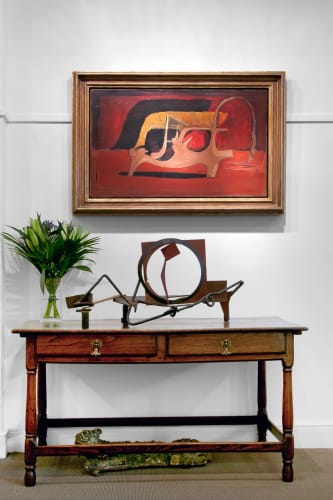Graham Sutherland was born in London. Though he initially worked as an engineer on the railways, he took up a place at Goldsmiths School of Art in 1921. A man of deep religious convictions, following an early conversion to Catholicism, his work is often filled with spiritual reference. One of his most famous works is his tapestry depicting Christ in Glory, which was unveiled in Coventry Cathedral in 1962.
Sutherland trained as an etcher and Goldsmiths and began painting in 1930s. During this time, he found particular inspiration in the remote landscape of Pembrokeshire. His concentration on the minutiae of organic growth, in which he found a reflection of the ‘divine order’, coupled with his feeling for descriptive line and his sensuous use of colour, resulted in the development of a highly recognisable, personal style.
He was flexible in his use of medium: ranging from painting and stained glass to fabric work and print making. He taught many of these varied skills at the Chelsea School of Art. When the establishment closed at the beginning of the Second World War, however, he moved to Gloucestershire and was offered a job as a salaried war artist by the War Artists’ Advisory Committee. The paintings that he did in this role were firstly focused on the destruction of the Blitz, both in Wales and in London. This “Devastation” series concentrates on the broken remains of the bombed buildings. No human remains are present. This was a restriction put in place by the war propaganda regulations but which served to make the pieces all the more moving; their lonely desolation is haunting. In 1941, whilst still working for the WAAC, he began working on a series of paintings of men working in mines and quarries across the country. He painted his first portrait in 1949. The sitter was the author, Somerset Maugham. His most well-known portrait was that of Sir Winston Churchill, which was famously hated by Churchill and destroyed by his wife. In his later years he spent a lot of time heading back to Wales for inspiration and devoted much of his energy to print-making.
Major retrospectives of his work have been held at the ICA, the Tate, the Dulwich Picture Gallery and the Musée Picasso.
